Strawberries can be found on almost every garden plot, while The most popular is the variety Festival.
It has many positive qualities, the main of which are high yields and unpretentiousness to the growing conditions, including the winter temperatures.
Table of contents
Description of a grade of strawberry Festival Camomile
Bush at the festival strawberry vigorous, but at the same time compact, the leaves are located quite high and closely.
Peduncles thick and powerful, able to withstand the weight of ripe berries, most often they are on the same level with the leaves or slightly below them. Inflorescences are very neat, flowers bisexual.
According to the description fruiting occurs in medium or late terms and at the same time lasts a long time, until mid-October-early November.
The berries of an oblong shape are colored bright red, while the skin is shiny and smooth. The neck is wide and even. On the entire surface of such strawberries are located red, small seeds.
The flesh is light pink, tender, but at the same time dense, thanks to which the variety tolerates transportation and long storage.
The taste of berries is pleasant, sweet and sour. with a delicate aroma. You can use such strawberries for different purposes.
Festival Chamomile is famous for its resistance to various diseases and pests, but still on such a plant you can see powdery mildew or verticillous wilt. Such a strawberry tolerates winter frosts.
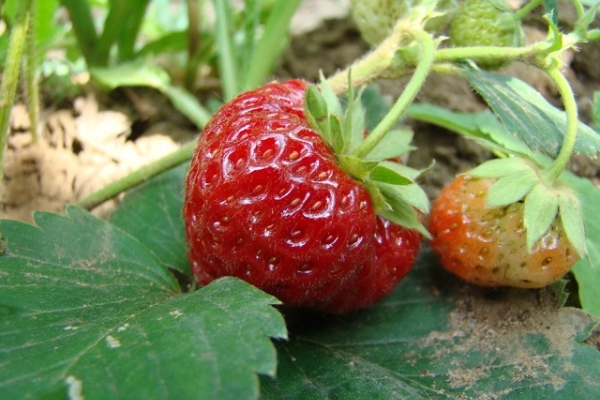
Breeding history and region of growth
Festival Strawberry was bred in Pavlovsk domestic breeders who have been working hard for 4 years, from 1954 to 1958.
Despite the fact that Festival is considered an old variety, many hybrid species so far have not been able to overshadow its characteristics.
Such strawberries are grown in the Central and Northern regions.in the Urals and Siberia.
Such unusual preferences are associated with the fact that the variety tolerates cold, but at the same time is very susceptible to drought and heat, so southern areas are not suitable for its cultivation.

Advantages and disadvantages
Grade advantages:
- good yield;
- excellent taste of berries;
- received berries tolerate transportation and are stored for a long time;
- the first fruits can boast a large size;
- long period of fruiting;
- variety can grow productively in the penumbra;
- the plant is not afraid of winter frosts, flower buds are not affected during frosts, and damaged bushes recover very quickly.
Disadvantages:
- the variety is often affected by some diseases;
- The plant does not tolerate heat and drought.
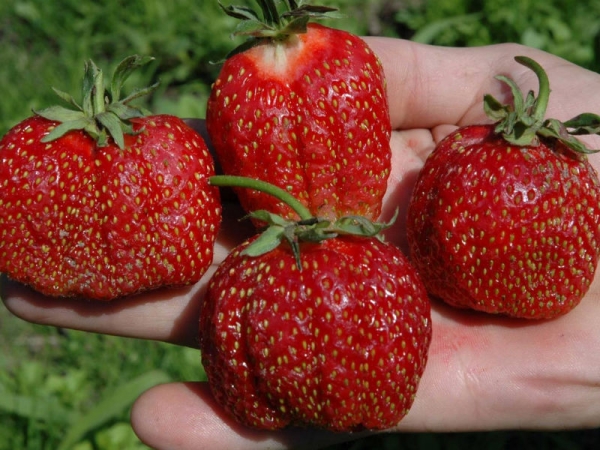
Landing rules
Works on planting the Festival in the open ground are usually held in the springwhen the threat of recurrent frosts is over or in early spring. In the second case, you need to take care that the plant has had time to settle down and does not freeze over the winter.
When choosing a place for strawberries, you should consider its requirements.:
- Best of all are slightly acidic loamy or sandy loam soils.
- The site should be well lit, but at the same time protected from direct sunlight.
- Drafts affect the plant negatively.
- The groundwater level should not be less than 80 centimeters.
For the most successful growth of seedlings, in the autumn, six months before planting, the soil is dug up to a depth of 25 centimeters, cleaned of weeds and the following fertilizers are applied (per 1 square meter):
- 5-6 kilograms of manure or peat;
- 50 grams of superphosphate;
- 20-30 grams of potash compounds.
Landing process strawberries in open ground is as follows:
- Initially digging shallow planting pits, the distance between which should be at least 30 centimeters.
- The wells are poured abundantly with water.
- In seedlings, the roots are slightly shortened and the leaves are pinched, leaving 3–4 strongest and most powerful.
- The plant is placed so that the root neck is at ground level.
- The final stage will be abundant watering.
If strawberries are planted in the fall, then it must be additionally covered.
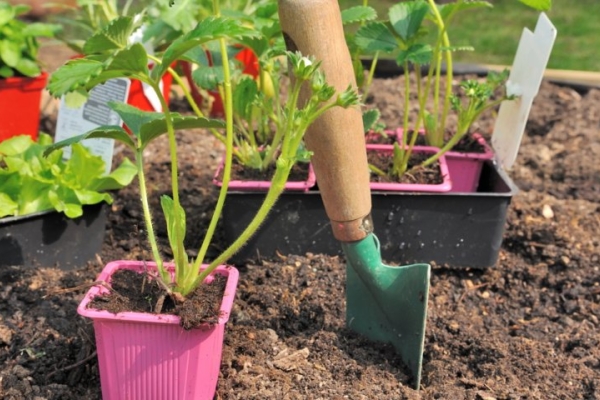
Garden Berry Care
Caring for the Festival is simple enough and even a beginner can handle it.
Watering strawberries consists of several ground rules.that should be considered when implementing care:
- watering starts in April;
- per 1 square meter of plantation using 10-12 liters of warm water;
- at moderate temperatures, the ridges are watered once every two weeks;
- in the hot period it will be necessary to moisten the soil every 2-3 days;
- if there is little precipitation in the fall, watering the strawberries should be continued and repeated every 5 days;
- during the work should not be allowed to get water on the plant, which are in the flowering or fruiting stage.
Every 7-10 days the beds must be carefully loosened. and clean weeds. This will help them get as much oxygen as possible.
To prevent the rapid evaporation of moisture and stop the growth of weeds, row spacing needs to be mulched straw, grass or peat.
Festival Strawberry needs regular feedings, which are carried out according to the following scheme:
| In early spring, immediately after the snow melts | Complex mineral fertilizers |
| During flowering fertilizers are applied once a week. | 200 milliliters of bird droppings diluted in 4 liters of water and watered with a mixture of one bush |
| At the end of fruiting | Superphosphate, 50 grams of which is diluted in a bucket of water |
Experienced gardeners recommend feeding directly after watering.
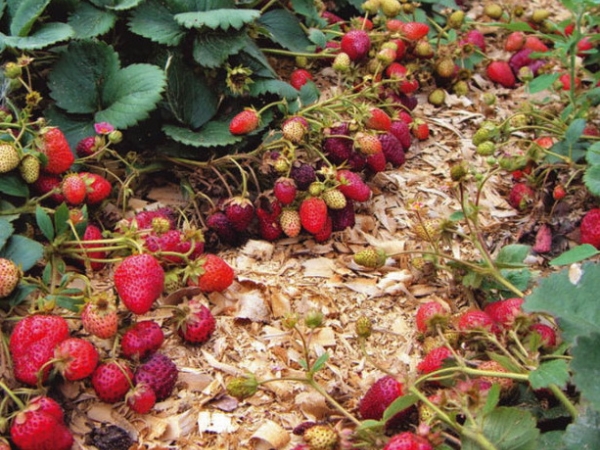
Breeding
Festival strawberries can be propagated in several ways., but it should be borne in mind that vegetative methods most often end in success, and when germinating seeds there is a risk to get a plant other than the mother.
To get seedlings from seed, perform the following actions:
- at the end of February and at the beginning of March, they prepare a fertile mixture consisting of equal parts of sand and peat, moisturize and spread the seeds on the surface, which are then slightly pressed deep into;
- the container is covered with glass or film and put in a warm place, occasionally aerating and pouring;
- After 2-3 weeks, the first shoots should appear and the seedlings can be swooped in separate containers
- As soon as 3-4 rosettes of leaves appear on the seedlings, they can be transferred to open ground.
As soon as a root rosette forms on it, it is placed in a separate pot and instilled in the soil, after which it is treated like a seedling. In a few weeks the young bush can be separated from the mother plant.
You can also use the method of dividing the bush, according to which an adult plant is dug out of the ground and divided into several parts.
It should be noted that there should be 3-4 leaf sockets and healthy, powerful roots on each delenka.
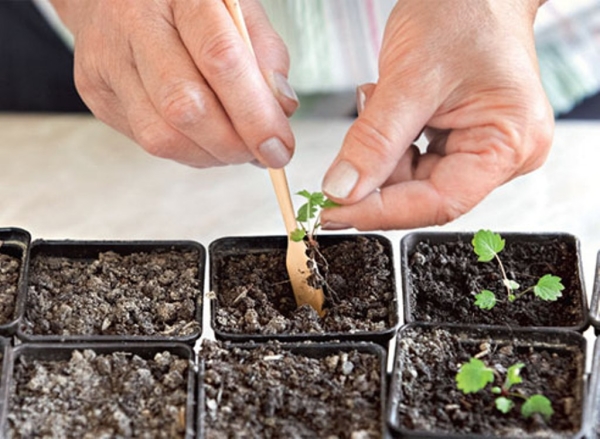
Diseases and pests
Festival strawberries, as well as other plants are affected by various diseases. Most often in the bushes you can see gray mold, powdery mildew or verticillary wilt.
| Disease | Methods of struggle |
| Gray rot | In early spring, before the formation of buds, the plant is sprayed with the preparations "Topsin M", "Zuparen", "Derozal", etc. If the summer was rainy, the treatment is repeated after flowering. |
| Mealy dew | At the initial stages of the disease, the drug “Trichoderma” is effective, in the event that the disease is highly spread, it is necessary to use broad-spectrum fugnicides. |
| Verticillary wilting | If you start treating a disease in time, biopreparations can become good remedies (“Phytodoc”, “Fitosporin”, etc.). At the advanced stages apply Brodsky liquid or "Fundazol". |
Prevention of diseases and pests is as follows:
- In early winter, the mulch is removed from the beds and the leaves of the plants are removed, after which the soil is loosened to a depth of 6-8 centimeters and treated with Brod's liquid or copper sulfate.
- At the end of September, the plants and the ground around them are treated with the following composition:
- 5 liters of water;
- 2 tablespoons of vegetable oil;
- 1 tablespoon of liquid soap;
- 1 tablespoon of ash;
- 1 tablespoon of vinegar.
- After 2 weeks, the treatment is repeated using Brodian liquid.
Festival Strawberry is a famous variety of domestic breeding.which does not lose its popularity for more than 50 years.
Such plants bring a rich harvest, consisting of large and very tasty berries.
